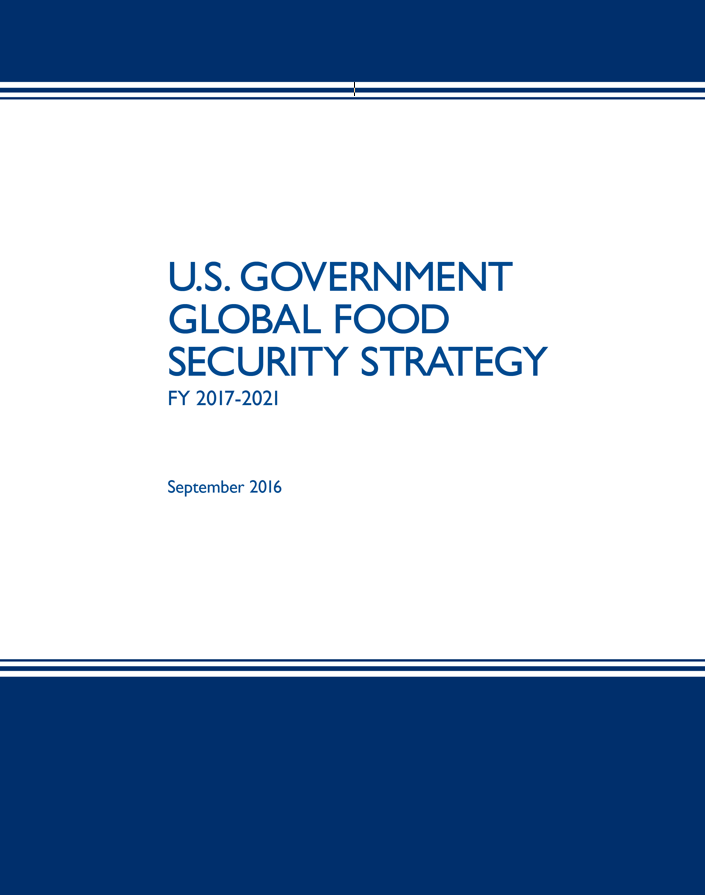- What We Do
- Agriculture and Food Security
- Democracy, Human Rights and Governance
- Economic Growth and Trade
- Education
- Ending Extreme Poverty
- Environment and Global Climate Change
- Gender Equality and Women's Empowerment
- Global Health
- Water and Sanitation
- Working in Crises and Conflict
- U.S. Global Development Lab
This Global Food Security Strategy presents an integrated whole-of-government strategy and agency-specific implementation plans as required by the Global Food Security Act of 2016 (GFSA).
This strategy reflects the unique skills, resources, and lessons learned from U.S. federal departments and agencies that contribute to global food security, as well as input from partners throughout the private sector, academic institutions, and civil society. It charts a course for the U.S. Government to contribute to the achievement of global food security and the range of Sustainable Development Goals (SDGs), together with partners across the globe.
Right now, the world is closer than ever before to ending global hunger, undernutrition, and extreme poverty, but significant challenges and opportunities remain, including urbanization, gender inequality, instability and conflict, the effects of a changing climate, and environmental degradation. Despite our collective progress in global food security and nutrition over recent years, a projected 702 million people still live in extreme poverty, nearly 800 million people around the world are chronically undernourished, and 159 million children under five are stunted. Food security is not just an economic and humanitarian issue; it is also a matter of security, as growing concentrations of poverty and hunger leave countries and communities vulnerable to increased instability, conflict, and violence.
The U.S. Government, in partnership with other governments, civil society, multilateral development institutions, research institutions, universities, and the private sector, will build on experience to date to address these challenges, take advantage of opportunities, and advance food security and improved nutrition by focusing efforts around three interrelated and interdependent objectives:
- Inclusive and sustainable agricultural-led economic growth, as growth in the agriculture sector has been shown in some areas to be more effective than growth in other sectors at helping men and women lift themselves out of extreme poverty and hunger. It does this by increasing availability of food, generating income from production, creating employment and entrepreneurship opportunities throughout value chains, and spurring growth in rural and urban economies.
- Strengthened resilience among people and systems, as increasingly frequent and intense shocks and stresses threaten the ability of men, women, and families to sustainably emerge from poverty.
- A well-nourished population, especially among women and children, as undernutrition, particularly during the 1,000 days from pregnancy to a child’s second birthday, leads to lower levels of educational attainment, productivity, lifetime earnings, and economic growth rates.
Through this approach, we will strengthen the capacity of all participants throughout the food and agriculture system, paying special attention to women, the extreme poor, small-scale producers, youth, marginalized communities, and small and medium enterprises.
Several key elements of our approach strengthen our ability to achieve these objectives. The first is targeting our investments in countries and geographic areas where we have the greatest potential to sustainably improve food security and nutrition and strategically focusing our resources on those approaches and interventions that evidence shows will reduce extreme poverty, hunger, and malnutrition at scale. The second is implementing a comprehensive, multi-faceted whole-of-government approach rooted in lessons learned and evidence to date that reflects emerging trends. The third is country leadership, recognizing that developing countries, above all others, must own and be empowered to lead and guide these efforts to drive progress. The fourth is partnerships with a wide range of development actors and groups, which will improve the reach, effectiveness, efficiency, and sustainability of our efforts. This includes using foreign aid strategically to catalyze domestic resource mobilization and private sector-driven trade and economic development. The fifth is harnessing the power of science, technology, and innovation to dramatically improve food and agriculture system practices as well as increase local capacity to address these issues. Finally, we will focus on the sustainability of our programs as we work to create the conditions where our assistance is no longer needed, including reducing susceptibility to recurrent food crises and large international expenditures on humanitarian assistance and ensuring a sustainable food and agriculture system with adequate and appropriate finance available to key actors.
To measure progress and remain accountable to the public, U.S. Government partners commit to continuing and strengthening our rigorous monitoring, evaluation, and learning (MEL) approach, which includes:
- A common Results Framework
- A performance monitoring process and standard performance indicators
- An evaluation approach using impact and performance evaluations
- A learning agenda that prioritizes key evidence gaps
- A focus on strengthening target country data systems
Inspired by the global agenda laid out in the SDGs and the objectives of the GFSA:
Our vision is a world free from hunger, malnutrition, and extreme poverty, where thriving local economies generate increased income for all people; where people consume balanced and nutritious diets, and children grow up healthy and reach their full potential; and where resilient households and communities face fewer and less severe shocks, have less vulnerability to the shocks they do face, and are helping to accelerate inclusive, sustainable economic growth.
This strategy builds on the U.S. Government’s strong foundation of global food security and nutrition investments and aims to break silos, integrating programming across sectors and agencies for maximum impact and effective stewardship of United States taxpayer dollars. By implementing this whole-ofgovernment strategy over the next five years, we believe that, together with our many partners across the globe, we can achieve this vision within our lifetimes.








Comment
Make a general inquiry or suggest an improvement.